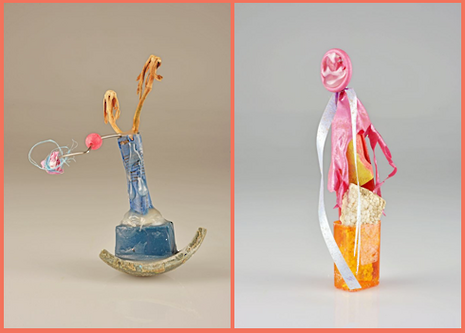Review: David Kefford’s Pocket Sculptures
Sarah Wilson discusses the Pocket Sculptures exhibition by local artist David Kefford

Somewhat ironically, I almost missed David Kefford’s pocket sculptures as I walked into the Alison Richard Building. I looked around for a ‘gallery’ space, only to find that the works were in glass cases next to the reception, sofas, and cafeteria in the next room: an in between space of sorts. But this setting well suited the nature of Kefford’s pieces, which have been created through an ongoing process in which he crafts sculptures from discarded materials found on walks around Cambridge: bottle caps, stones, and cable ties among other things. It seems only appropriate that these pieces might also be happened upon by viewers en route.
The exhibition relies on space, scale, and movement for impact, as the individual sculptures stand markedly separate from one another, even within the glass cases, and the viewer is free to move around them at any distance or angle. A few paces away, the sculptures appear like tiny plasticine towers, as the material’s colours are surprisingly vibrant. The sense one gets is of a playful and dextrous method; when standing apart from the cases it would be easy to interpret the sculptures as a kind of child’s play, and indeed, though the scope of the imagination is great, as one draws closer to the pieces the fine and careful craft of the works becomes apparent. Each sculpture bloomed expressively upwards from a base slab of stone, polystyrene or brick. No one sculpture was like the other, and it seemed a merit that none were labelled or named; it felt a part of Kefford’s playfulness that the shapes and movements implied by the structures were entirely in the interpretive hands of the viewer. One particular sculpture, for instance, appeared to me as Rudolph the red-nosed reindeer, using what looked like a long pen lid as the body, and a wire with a small red bead on the end for a nose. What may have been brown string or dried pieces of grass curled up from the top of the ‘body’, forming antlers. I was somewhat amused what I’d thought I’d seen, but upon reflection I found this impression interesting in itself.
"Kefford has crafted pieces which, up close, are sturdy and substantial in spite of the delicate and intricate nature of the materials he works with"
Kefford is interested in the situations beyond the final, static product. He is interested in the situations in which these pieces are made and viewed, and as such they will appear differently to each viewer, depending on what they each bring to the pieces, or their distance or position with relation to the case. The smallness of each sculpture means things here are easily missed, and one material may be mistaken for another, or interpreted as representing something else.
Frequently, I mistook pieces of string and cable ties for dried out pieces of grass. Kefford chooses to confuse the boundary between the cultural and natural in this way across the exhibition, lending the sculptures an uncanniness as the viewer is reminded that the appealing and often beautiful sculptures have been crafted from materials we would ordinarily consider waste. A withered balloon hanging over the tip of one sculpture was an oddly unsettling example.
Kefford has crafted pieces which, up close, are sturdy and substantial in spite of the delicate and intricate nature of the materials he works with. Ordinarily flimsy and paltry pieces of plastic, string, and wire seemed to balance precariously but deliberately upon each other, giving a pleasing sense of improvisation and incidental invention. Many seemed to provoke narratives. One piece in particular hosted a slab of polystyrene laid on its side, with a red-wire and ribbon-formed figure leaning against it. On the other side, pressing back against the push of the figure was a red ball of screwed-up plastic. The pieces were positioned as such to emphasise the forces working from both sides of the polystyrene, which seemed to represent a large rock. The small red figure was dwarfed against the polystyrene, pushing against it with futility, in a surprisingly powerful scene of endurance. Here and elsewhere, the power and endurance these objects seem to perform lends the sculptures a likeness to the body. This is an effect embodied also in the fact of the material itself: as objects discarded by humans. The confrontation with our own waste here teases out the neglectful and depreciative relationships between us and the material we discard, and Kefford does so thoughtfully, without overstatement.
A deceptively simplistic premise here finds a complex execution. Kefford’s exhibition is playful, intuitive, and transformative, and worth taking the time to explore
 News / Eight Cambridge researchers awarded €17m in ERC research grants27 December 2025
News / Eight Cambridge researchers awarded €17m in ERC research grants27 December 2025 News / Downing investigates ‘mysterious’ underground burial vault 29 December 2025
News / Downing investigates ‘mysterious’ underground burial vault 29 December 2025 Lifestyle / Ask Auntie Alice29 December 2025
Lifestyle / Ask Auntie Alice29 December 2025 Sport / Hard work, heartbreak and hope: international gymnast Maddie Marshall’s journey 29 December 2025
Sport / Hard work, heartbreak and hope: international gymnast Maddie Marshall’s journey 29 December 2025 Interviews / Meet Juan Michel, Cambridge’s multilingual musician29 December 2025
Interviews / Meet Juan Michel, Cambridge’s multilingual musician29 December 2025






